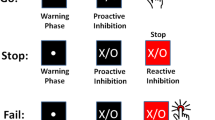Abstract
The precise localization of executive functions such as response inhibition within the prefrontal cortex (PFC), although theoretically crucial, has proven to be controversial and difficult1. Functional neuroimaging has contributed importantly to this debate1,2,3,4,5,6,7, but as human cortical lesions are seldom discrete, the literature still lacks definitive neuropsychological evidence that a specific region is necessary for task performance. We overcame this limitation by using a new observer-independent method to relate the degree of damage within a specific prefrontal region to performance on a stop-signal task that is sensitive to the neurodevelopmental aspects of stopping behavior2 and to attention-deficit/hyperactivity disorder (ADHD) as well as its amelioration by methylphenidate5,8.



Similar content being viewed by others
References
Duncan, J. & Owen, A.M. Trends Neurosci. 23, 475–483 (2000).
Bunge, S.A., Dudukovic, N.M., Thomason, M.E., Vaidya, C.J. & Gabrieli, J.D.E. Neuron 33, 301–311 (2002).
Menon, V., Adleman, N.E., White, C.D., Glover, G.H. & Reiss, A.L. Hum. Brain Mapp. 12, 131–143 (2001).
Garavan, H., Ross, T.J. & Stein, E.A. Proc. Natl. Acad. Sci. USA 96, 8301–8306 (1999).
Rubia, K. et al. Am. J. Psychiatry 156, 891–896 (1999).
Konishi, S., Nakajima, K., Uchida, I., Sekihara, K. & Miyashita, Y. Eur. J. Neurosci. 10, 1209–1213 (1998).
Konishi, S. et al. Brain 122, 981–991 (1999).
Logan, G.D., Schachar, R.J. & Tannock, R. in Attention and Performance XVIII (eds. Monsell, S. & Driver, J.) 653–677 (MIT Press, Cambridge, Massachusetts, 2000).
Brett, M., Leff, A.P., Rorden, C. & Ashburner, J. Neuroimage 14, 486–500 (2001).
Logan, G.D. in Inhibitory Processes in Attention, Memory and Language (eds. Dagenbach, D. & Carr, T.H.) 189–239 (Academic, San Diego, 1994).
Williams, E.J. J. Roy. Stat. Soc. (Series B) 21, 396–399 (1959).
Tzourio-Mazoyer, N. et al. Neuroimage 15, 273–289 (2002).
Goldman-Rakic, P.S. Philos. Trans. R. Soc. Lond. B Biol. Sci. 351, 1445–1453 (1996).
Acknowledgements
Patients were studied through the CCNRP, Cambridge, UK with thanks to N. Antoun. The interleaved staircases variant of the stop-signal test was developed through a Stroke Association (UK) grant to S. Monsell and I. Robertson. This work was supported by a MRC studentship to A.R.A. and a Wellcome Trust Programme Grant to B.J.S. and T.W.R. within the MRC Centre for Behavioural and Clinical Neuroscience.
Author information
Authors and Affiliations
Corresponding author
Ethics declarations
Competing interests
The authors declare no competing financial interests.
Supplementary information
Rights and permissions
About this article
Cite this article
Aron, A., Fletcher, P., Bullmore, E. et al. Stop-signal inhibition disrupted by damage to right inferior frontal gyrus in humans. Nat Neurosci 6, 115–116 (2003). https://doi.org/10.1038/nn1003
Received:
Accepted:
Published:
Issue Date:
DOI: https://doi.org/10.1038/nn1003
- Springer Nature America, Inc.
This article is cited by
-
No effects of 1 Hz offline TMS on performance in the stop-signal game
Scientific Reports (2023)
-
Genotype-by-diagnosis interaction influences self-control in human cocaine addiction
Translational Psychiatry (2023)
-
A generalized reinforcement learning based deep neural network agent model for diverse cognitive constructs
Scientific Reports (2023)
-
Cortical and subcortical structural differences in psychostimulant-free ADHD youth with and without a family history of bipolar I disorder: a cross-sectional morphometric comparison
Translational Psychiatry (2023)
-
Same, Same but Different? A Multi-Method Review of the Processes Underlying Executive Control
Neuropsychology Review (2023)





